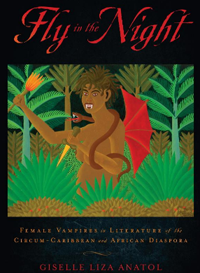Vampires aren't just 'Twilight' sexy or 'Dracula' old, new book finds
LAWRENCE — Despite the images depicted in the uber-popular "Twilight" movies based on the books by Stephenie Meyer, vampires haven't always been portrayed as young and sexy in literature. Nor were they always simply in the mold of Bram Stoker's Dracula, an old, blood-sucking Eastern European man.
 A University of Kansas professor's new book examines images of vampirism in Caribbean and African diasporic folk traditions and in contemporary fiction. The figure of the "soucouyant" in Caribbean tradition — also called “loogaroo” and "Old Hag" — is an elderly woman who sheds her skin during the night and flies around her community to suck the blood from her unwitting victims.
A University of Kansas professor's new book examines images of vampirism in Caribbean and African diasporic folk traditions and in contemporary fiction. The figure of the "soucouyant" in Caribbean tradition — also called “loogaroo” and "Old Hag" — is an elderly woman who sheds her skin during the night and flies around her community to suck the blood from her unwitting victims.
"We have for so long fixated on Stoker's Dracula and other European vampires as the origins and the only way these creatures can be represented that we neglect all of the other cultural manifestations that are not presented in the same ways or interpreted in the same ways," said Giselle Liza Anatol, a KU associate professor of English.
 Rutgers University Press has just released her book "The Things That Fly in the Night: Female Vampires in Literature of the Circum-Caribbean and African Diaspora." Anatol, whose family is from Trinidad, researched the book at the Trinidad campus of the University of the West Indies and at the Schomburg Center for Research in Black Culture in Harlem. She said her initial project was to look at what generated the fear of skin-shedding vampires in Caribbean culture.
Rutgers University Press has just released her book "The Things That Fly in the Night: Female Vampires in Literature of the Circum-Caribbean and African Diaspora." Anatol, whose family is from Trinidad, researched the book at the Trinidad campus of the University of the West Indies and at the Schomburg Center for Research in Black Culture in Harlem. She said her initial project was to look at what generated the fear of skin-shedding vampires in Caribbean culture.
"If we look at the folk figure through the European or an American lens, it might only be the blood sucking because that's what we've come to associate with vampires," she said.
However, because of her own experience of hearing the Caribbean folktales as she was growing up, she wanted to explore the implications of gender, age and race in vampire stories.
"It's not just about the fact that your blood is taken. The penetration of one’s skin and the exchange of this vital essence — which is blood — suggests that this is a sexual interaction. But with the soucouyant stories it's also the fact that this creature is so changeable and so mutable," Anatol said. "Someone who can peel off her skin is very frightening, but what does this mean for our understanding of racial identity? What are we to do with the fact that this creature appears to be an old woman by day and looks weak and fragile, but then at night she has all of this power?"
Tracing relevant folklore, Anatol said the "soucouyant" figure was typically used to encourage children to be obedient but also to fortify certain perceptions about the role of women and older people in the Caribbean and in the U.S. Deep South.
"The figure was always female. So what is it about a woman having this power that is exceptionally frightening?" Anatol said. "I think it points to the kind of social attempts to contain and control women who live alone or women who are constantly taking from others and satisfying their own desires instead of nurturing and giving to others. If you don't function as you're supposed to, then you're seen as this evil creature."
Young girls would be told these folklore stories as an example of how they're supposed to act, and boys would learn "what they're entitled to," she said.
The dark cloud of slavery in the region likely played a part as well — something that bears out as a theme in more contemporary short stories and novels, such as Edwidge Danticat's "1937" and Toni Morrison's "Beloved."
Anatol points to the scene in "Beloved" in which the ghostly figure — thought to be the daughter of the protagonist — keeps growing and swelling while the mother gets smaller.
"I look at how Morrison is playing with ideas of sucking the life out of someone, in vampiric terms, but also how she plays that against a society that has done that — especially during slavery —when enslaved African American people brutally had the life sucked out of them," Anatol said.
She hopes the book will broaden readers' horizons about the literary use of vampire figures, allowing them to get beyond the simple idea of European origins or the Eurocentric pop-culture examples that are prevalent today.
"One of the reasons why this study is really important is to remind people of what a diverse world we live in," Anatol said. "I think this is a way to open up that discussion of categories: that there's not just one way to do anything or be anything. There's not just one way to be a vampire. There's not just one way to be an American. There's not just one way to be black."